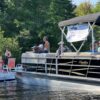Here is some helpful background in the 2020 Watershed Protection Plan
- The format and content of this plan is dictated by the Maine DEP and US EPA. The plan explains water quality conditions, sets water quality goals, documents shoreline conditions, notes current and potential runoff risk areas, and details suggested next steps for improvements around the lake.
- Environmental scientists performed their field evaluations in the spring of 2019. Evaluations of Watchic Lake properties were generally done from the water, and in some cases on properties with permission of the owner. Evaluations of streams, roads and culverts were done during this same time, and often during/after heavy rainstorms. GPS coordinates and photos were taken of each site.
- Total phosphorous entering the lake from the top 25 risk sites was calculated (page 41 and 42). A bit more detail is provided on the top 10 of these sites (pages 33 to 39).
- Each Watchic Lake property was evaluated for runoff risk using a Maine DEP approved scoring mechanism. The scoring is described on Page 43 to 49 of the report. This scoring is used to help property owners understand any erosion risks associated with their property, and to help guide the WLA in securing grants. Scoring evaluated Buffer/Vegetation Zone, the amount of Bare Soil, extent of any Shoreline Erosion, distance of Structures from the lake, and property Slope.
- Note that most properties on the lake scored in the “moderate erosion risk” range (gold on the map). A smaller number (red on the map) scored with a “high erosion risk” range. This highlights the fact improved erosion control measures are needed on most properties on the lake.
- The Town of Standish has reviewed this plan, and is supportive of addressing issues under their control and helping us secure grants for such work.
As background, the largest long-term concerns for water quality at Watchic Lake are related to development in and around the Watchic Lake watershed. The increased use of the lake by renters, planes, and new owners; raise the risk of an invasive plant infestation and pollutants (e.g., phosphorus) from stormwater runoff (which increase the risk of algal blooms and generally reduce water quality). The possibility of a “100-year storm” increases the risk for a catastrophic failure of roads and culverts around the lake.


